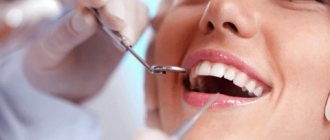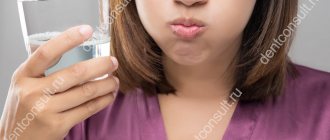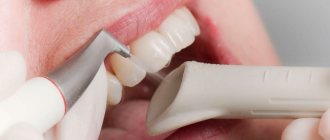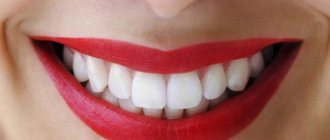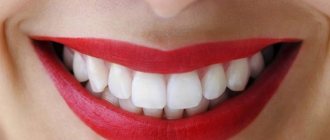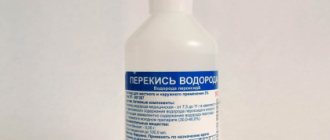Content:
- The importance of choosing the right medicine
- Conditions that must be met by high-quality compositions 2.1. Iodine preparations 2.2. Chlorine 2.3. Preparations based on hexethidine
- For what purpose is it used?
- Indications for use
- How to rinse your mouth correctly
For various dental diseases, doctors often prescribe oral antiseptics.
They reduce the severity of painful symptoms, wash away pathogens from mucous membranes, and improve local blood circulation. With their help, it is possible to slow down the spread of microbial flora and speed up regeneration reactions. of mouth antiseptics on the market , but this does not mean that all of them are safe and effective. During treatment, it is necessary to use exactly the product prescribed by the dentist. Self-selection of medications often makes therapy ineffective or creates conditions for relapse of infection.
The importance of choosing the right medicine
It is impossible to completely destroy microorganisms living in the human mouth. But when treating some diseases and conditions, it is necessary to temporarily reduce their number for a short time. Modern antiseptics help a lot with this.
It should be understood that those solutions that are used to treat the skin should not be taken by mouth. Firstly, it is fraught with poisoning. All sanitizers for external use are not intended for oral use.
Secondly, such therapy is always pointless. This is explained by the fact that the human mouth is inhabited by bacteria. Unsuitable products are inactivated by salivary proteins. This means that they do not work on the mucous membranes of the tongue and gums.
Conditions that quality compounds must satisfy
Good developments used by dentists for aseptic purposes must meet a number of requirements:
- exhibit high activity against fungi, viruses, bacteria;
- provide a reliable clinical effect when used in low concentrations;
- in the case of systemic absorption, do not have a pronounced negative effect on the body or internal organs;
- be characterized by a minimal risk of synthesization;
- do not cause poisoning if used in the dosages established by the manufacturer;
- have a neutral smell and taste.
Among the most popular medications that meet these requirements:
- made from iodine;
- including chlorine;
- containing hexetidine.
Let's look at each type of mouth antiseptic in more detail.
Iodine preparations
Iodine is a substance that exhibits pronounced antiseptic properties. It destroys many fungi and microbes and acts as an effective antiprotozoal. Relieves pain, deodorizes, helps to quickly stop bleeding. They are allowed to cauterize wounds.
When treating mucous membranes, undiluted iodine is not used - it must be diluted in the required proportion. Otherwise, you can get a burn to the delicate membranes, which will take a long time to heal.
Iodine must not be combined with alkali, mercury, enzymes, or oxidizing agents. It is also pharmacologically incompatible with ammonia and ethers.
Chlorine
The most prominent representative of the chlorine-containing group is chlorhexidine, a biguanide derivative. It oxidizes and chlorinates proteins, causing their denaturation. As a result, a pronounced deodorizing and antiseptic effect is ensured, pathogenic tissues are destroyed.
Chlorhexidine is found in many oral antiseptics. It is even included in preventive toothpastes. It destroys gram-negative and gram-positive bacteria, fungi, anaerobes, herpes, facultative aerobes. With regular use, the content of pathogenic microorganisms in saliva is reduced by approximately 80-90%. As a result, the rate of plaque deposition is reduced and stone prevention is ensured.
The therapeutic effect of chlorhexidine is explained by the interaction of its positively charged molecules with negative groups of molecules in the bacterial cell wall. The component quickly penetrates the inflammatory focus, reaches the cytoplasmic layers of the microorganism and kills it.
Interestingly, the product is selectively absorbed onto enamel hydroxyapatite . This means that it does not allow bacteria to multiply on the surface of the dental crown. Since it binds tightly to proteins, the therapeutic effect is prolonged - the release of antiseptic substances occurs gradually.
In addition to antibacterial activity, chlorhexidine also exhibits a weak analgesic effect. It is important to remember that its use on an ongoing basis leads to dysbacteriosis. Therefore, there is no need to use chlorhexidine-containing drugs on an ongoing basis.
Do not combine the additive with soap, alkalis, or anionic detergents. It should be taken into account that it increases the sensitivity of the human body to chloramphenicol, cephalosporins, and aminoglycosides.
Preparations based on hexethidine
Hexethidine is a cell membrane destroyer. It accelerates the death of pathogenic organisms and disrupts the synthesis processes necessary for the spread of pathogenic flora. The antifungal activity of the drug is associated with its ability to interfere with the formation of compounds necessary for the formation of the fungal membrane.
It has been established that hexetidine is effective in pathologies caused by:
- mushrooms of the genus Candida;
- Proteus;
- Pseudomonas aeruginosa.
Medicines containing the component relieve pain, stop the spread of inflammation, deodorize and envelop wounds. They help with candidiasis, stomatitis, glossitis, periodontal disease, aphthae, and increased bleeding of the gums. Hexethidine is allowed to treat microtraumas and purulent-inflammatory areas. It is also used in the antiseptic treatment of root canals in the treatment of periodontitis and pulpitis.
One of the most common manifestations of acute upper respiratory tract infection and the most common reason for a patient to visit a doctor is pharyngitis (tonsillopharyngitis). In accordance with ICD-10, acute pharyngitis (J02), streptococcal pharyngitis (J02.0), acute pharyngitis caused by another specified pathogen (J02.8) are distinguished, while acute pharyngitis due to infectious mononucleosis, influenza and some others are excluded; acute pharyngitis, unspecified (J02.9). In addition, acute tonsillitis (J03), streptococcal tonsillitis (J03.0), acute tonsillitis caused by other specified pathogens (J03.8); acute tonsillitis, unspecified (J03.9). Naturally, this introduces a certain terminological uncertainty when formulating a diagnostic conclusion.
Considering that in acute pharyngitis, inflammation of the mucous membrane (MS) is rarely limited, for example, to the posterior wall of the pharynx, and almost always extends to the palatine arches, the surface of the palatine tonsils, the term “tonsillopharyngitis” is often used to refer to this condition, although in modern literature such conditions are often are regarded as “pharyngitis” ( streptococcal pharyngitis
). However, the term “acute tonsillopharyngitis” (ATP) appears to more accurately reflect the prevalence of inflammatory changes in the pharynx.
Most episodes of ATF are thought to have a viral etiology, with bacteria causing only 20-30% of the disease in children and 5-15% in adults. Noteworthy is the extreme similarity of the clinical symptoms of acute pharyngitis of bacterial and viral etiology, which significantly complicates the differential diagnosis of these conditions in everyday practice. This circumstance often serves as a source of erroneous use of antibacterial drugs, up to 75% of which, according to WHO experts, are used irrationally [1]. A fairly clear illustration of the unjustified use of antibiotics is their prescription to 95% of patients with symptoms of ATF [2]. According to a multicenter study conducted in Russia, sore throat was the basis for the prescription of antibiotics in 95% of patients [2]. In the USA, this figure was 73% [3].
However, it is known that the absolute indication for antibiotic therapy is ATP caused by group A β-hemolytic streptococcus (GABHS).
The most characteristic clinical manifestations of streptococcal ATF include local signs of inflammation of the palatine tonsils (hyperemia, the presence of plaque, exudate on the surface), cervical lymphadenitis, fever, and the absence of so-called respiratory symptoms. The rules for clinical prediction of streptococcal infection R. Centor are based on this [4]. It is believed that if a patient has 3 or 4 such signs, the probability that the disease is truly caused by GABHS is 40-60%, and with negative test results, the probability of a non-streptococcal etiology of ATF reaches 80%. To resolve the issue of indications for antibacterial therapy in ATF, it is also recommended to use the W. McClsaac scale, which, in addition to the criteria proposed by R. Centor, takes into account the patient’s age [5]. The feasibility of this approach is due to the fact that, as already noted, in the age group under 15 years of age the likelihood of streptococcal tonsillopharyngitis is higher than in persons over 45 years of age. It should be emphasized that the differential diagnostic value of the listed criteria is to a certain extent relative, however, in everyday practice, with their help it is possible with a certain degree of probability to assume the presence (absence) of streptococcal tonsillopharyngitis in a patient, determining the nature and scope of treatment measures.
It is also necessary to note the etiological significance in ATF of hemolytic streptococci not belonging to group A, among which the most common are streptococci of groups B, C, G. It has been shown that the frequency of isolation of β-hemolytic streptococcus not of group A in these cases reaches 21% [6]. These microbes, in particular streptococci of groups C and G, can also be causative agents of ATF and purulent-inflammatory processes of various localizations, and therefore, when such pathogens are identified, as in cases of ATF associated with GABHS, antibacterial treatment is indicated [7].
Along with complications such as rheumatic fever, glomerulonephritis, with ATP there is always a risk of the pathological process spreading to the peritonsillar tissue and the formation of purulent inflammation here - a peritonsillar abscess (PTA). GABHS is considered one of the most likely causative agents of PTA, which is more often than other microbes identified in throat smears and aspirate from the abscess cavity [8]. According to some estimates, the detection rate of GABHS in PTA reaches 43.7-45% [9]. In addition to GABHS, staphylococci and other microorganisms play an active role in the occurrence of PTA ( Haemophilus influenzae, Pseudomonas aeruginosa, Escherichia coli, Enterococcus
), which allows us to state the polymicrobial nature of the disease. Microbial associations are often tested in such patients (in 15.6% of patients); anaerobes are tested in approximately 14-23.5% of patients [9, 10]. In addition, viruses are important in the formation of PTA, which are found in the tissue of the tonsils of 69% of patients with PTA, while in 72% of such observations the Epstein-Barr virus is identified [11]. The persistence of a viral infection is accompanied by inhibition of local mechanisms of humoral immunity, in particular the production of immunoglobulin G, the low content of which in saliva is considered as an unfavorable prognostic sign and indicates a high probability of chronicity of focal infection in the palatine tonsils, relapses and/or a more severe course of PTA. There is reason to believe that these are the circumstances that contribute to the occurrence of PTA, for example, in patients with infectious mononucleosis, in whom the incidence of this disease can reach 23.4% [12, 13].
One of the earliest and most common symptoms of ATP and PTA is a sore throat. This is due to irritation (sensitization) of nociceptive nerve endings by proinflammatory mediators. In this case, the processes of vasodilation and transudation of plasma proteins are activated, the expression of highly active substances - serotonin, histamine, bradykinin, substance P, as well as products of the cyclooxygenase and lipoxygenase pathways of arachidonic acid metabolism - eicosanoids. The latter include prostaglandins, thromboxanes, leukotrienes and other biologically active substances that take an active part in the development of the infectious and inflammatory process.
The molecular mechanisms of pain are associated with TRP receptors (transient rezeptor potential), in particular the capsaicin receptor TRPV1 [14]. An important role in the activation of nociceptive nerve fibers is played by the CGRP peptide and substance P, and other neuropeptides, the action of which is accompanied by vasodilation and increased permeability of the vascular wall, activation of immunocompetent cells, and expression of inflammatory mediators. Against the background of these processes, as well as a decrease in pH at the site of inflammation, an increase in the thermal sensitivity of TRPV1 occurs, when even normal body temperature causes irritation of the receptor and a burning sensation. It is believed that this mechanism underlies the occurrence of long-term irritation of nociceptors and pain during inflammatory processes in the pharynx of various etiologies [14-17].
Thus, correct assessment of the clinical manifestations of the disease and timely prescribed treatment are extremely important conditions for choosing adequate treatment tactics, rapid regression of the intensity of clinical manifestations of the disease, in particular pain, and preventing unfavorable trends in the development of ATP.
According to modern recommendations, the first-line drugs for the treatment of streptococcal ATF are penicillins, in particular amoxicillin, which is characterized by high bioavailability [18]. This is primarily due to the absence of GABHS strains resistant to penicillins, due to which these antibiotics demonstrate high effectiveness against this pathogen over a fairly long period. At the same time, the increasing frequency of bacteriological ineffectiveness of penicillin against GABHS should be taken into account, therefore, in case of recurrent streptococcal ATF when the patient has taken antibiotics during the previous month, preference should be given to inhibitor-protected penicillins, in particular amoxicillin-clavulanate [19]. The feasibility of using this drug is associated with such well-known characteristics as a wide spectrum of antibacterial action, as well as activity against microorganisms sensitive to amoxicillin and strains producing β-lactamases.
In addition, cephalosporins - cephalexin, cefadroxil, cefuroxime, cefixime, ceftibuten - occupy an important place in the treatment of streptococcal tonsillopharyngitis [20, 21]. If you have a history of allergic reactions to β-lactams, you should use macrolides, which have antistreptococcal activity, the ability to create high concentrations in the tissues of the site of infection, in particular in the tonsils, ease of use and good tolerability. The relevance of the use of macrolides in acute/recurrent tonsillopharyngitis is also due to the increasing etiological role of intracellular pathogens in this disease [22].
An important component of the treatment of ATF of various etiologies is the rational use of local effects on the pharyngeal mucus. Most topical medications used for inflammatory diseases of the pharynx are represented by a variety of lozenges/lozenges containing various components. However, the need to dissolve the lozenge/tablet and frequently swallow the resulting saliva is accompanied by tension in the muscles of the tongue, floor of the mouth, soft palate, pharynx, larynx and increased pain in the throat.
Another group of medications used in these cases are aerosols containing antibiotics and antiseptics. As a rule, these are quite effective drugs, the fine particles of which penetrate into various parts of the respiratory tract - the nasal cavity, larynx, trachea, creating effective concentrations of the drug in them. At the same time, excess saliva and exudate (plaques) in the pharynx during OTP (PTA) complicate the contact of the aerosol with CO, and swallowing is accompanied by the removal (washing away) of a significant part of the particles deposited on the surface of the CO of the oropharynx. Therefore, before using such sprays for OTP (PTA), it is advisable to rinse the throat, and after insufflation, avoid eating and drinking.
One of the local treatment options used for inflammatory diseases of the pharynx is gargling (after a deep breath, the patient takes a medicinal liquid into his mouth, and, throwing his head back and slowly exhaling, continuously pronounces the sound “a-a-a...”). In this case, CO is cleansed from plaque (exudate), a deodorizing effect is ensured, as well as direct contact of the treatment solution with CO. However, rinsing is accompanied by contraction of the muscles of the pharynx and neck, and the occurrence/intensification of pain, so it is not indicated for patients with OTP with severe inflammatory changes and intense pain.
The so-called pharyngeal baths are more gentle (as with rinsing, after a deep breath the patient takes a small amount of medicinal liquid into his mouth, but, throwing his head back, does not make any sounds). During this procedure, the medicinal solution comes into close contact with CO, washing it and providing a mild, non-irritating, moisturizing and exudate-thinning effect. However, in this case, sufficient mechanical cleaning of the pharyngeal CO does not occur.
Another method of gargling, the so-called gluglurism, is an intermediate option between gargling and pharyngeal baths. To perform the procedure, the patient puts a medicinal solution into his mouth and, throwing his head back, pronounces the syllables “glu-glu...”. This ensures good irrigation and washing of the deeper parts of the pharynx, and minimizes the irritating effect of the procedure [23].
It has been shown that gargling with antiseptic solutions (povidone-iodine, benzalkonium chloride) has a bactericidal effect against the causative agent of whooping cough [24], and the use of black tea extract is an effective preventive measure for influenza [25].
A randomized placebo-controlled trial found that ketamine gargling (50 mg in 30 ml of drinking water for 30 s, 5 min before anesthesia) reduced the intensity of sore throat after tracheal intubation [26].
In general, gargling is considered a medically and economically effective preventive measure for upper respiratory tract infections [27]. It should be emphasized that during irrigation procedures, a significant area of contact of the solution with CO occurs, creating favorable conditions for better local effects [28].
In this regard, the attention of clinicians has traditionally been attracted by antibacterial solutions and the prospects for their use for rinsing in inflammatory diseases of the pharynx. One of these drugs is furasol, a nitrofuran derivative (the active ingredient is potassium furazidin, the excipient is sodium chloride), the action of which, according to the manufacturer’s instructions, is associated with the inactivation of bacterial ribosomal proteins, disruption of aerobic respiration - suppression of the activity of the respiratory chain and the tricarboxylic acid cycle (Krebs cycle) , as well as inhibition of other biochemical processes, which leads to the destruction of the bacterial membrane or cytoplasmic membrane. This diversity of action determines the weak acquired resistance of microorganisms to nitrofurans. In addition, nitrofurans increase complement titer and the ability of leukocytes to phagocytose microorganisms. Under the influence of potassium furazidin, the expression of toxins by microorganisms is reduced. It is noted that thanks to this, clinical effects (quick relief of the main symptoms of pharyngitis - reduction of pain, hyperemia of the posterior pharyngeal wall) can be recorded earlier than a decrease in the inoculation of pathogens. The drug is effective against gram-positive cocci ( Staphylococcus
spp.,
Streptococcus
spp.), which are, in particular, causative agents of ATF.
The drug is distinguished by good solubility, high bioavailability, safety compared to analogues and rapid achievement of a therapeutic effect. Furasol is contraindicated during pregnancy and lactation and in children under 4 years of age, due to the anatomical and physiological characteristics of childhood.
Furasol is available in powder form for the preparation of a solution for local and external use in 1 g sachets, which contains 100 mg of potassium furazidine (active ingredient). The contents of the sachet are dissolved in 200 ml of hot water, and the warm solution is used to rinse the mouth and oropharynx 2-3 times a day. The solution is prepared immediately before use.
It is noted that in cases of acute and exacerbation of chronic pharyngitis, the use of furasol helps reduce the duration of the disease by 1-2 days [29].
Another clinical study found that rinsing with furasol after tonsillectomy contributed to a more rapid relief of reactive phenomena in the pharynx, and therefore emphasizes the great importance of using the drug in the postoperative period [30].
Thus, as the results of clinical observations show, the use of a solution of the antibacterial drug furasol has a positive effect on the intensity and duration of inflammatory changes in the oropharynx, which indicates the advisability of its use in appropriate clinical situations.
In general, rinsing with antimicrobial solutions is accompanied by the removal of dense inflammatory products from the surface of the mucus, has a pronounced therapeutic effect, promoting the regression of pathological changes in the mucus and occupies an important place in the complex treatment of ATF of various etiologies.
For what purpose is it used?
Antiseptic solutions, gels and ointments are used for dental pathologies that require an integrated approach. They allow you to quickly stop the inflammatory process, efficiently cleanse the mucous membranes of infectious agents, and reduce pain in the teeth and gums. Their use is relevant during the recovery period after dental surgery (including the removal of a diseased tooth), to relieve swelling, and eliminate foul odor.
It should be remembered that drugs of this group can cause negative side reactions. So, sometimes instead of the long-awaited recovery, patients receive:
- tissue irritation;
- itching;
- peeling;
- increased sensitivity of the gums.
If such negative symptoms appear, you should stop treatment and get a second dental consultation . It is possible that the disorder was caused by other drugs that the patient applied to the tissue in parallel with the disinfectant medication. Therefore, it is advisable to immediately clarify the situation.
Which drug should I choose?
For sore throat, tonsillitis and diseases of the oral mucosa (stomatitis, gingivitis and others), the question arises: which drug to buy, an antiseptic or an NSAID?
Pros and cons of antiseptics
Antiseptics destroy microorganisms only on the surface, but they do not penetrate the tissues, and the source of inflammation is always located inside. In addition, the antiseptic does not eliminate the pain and swelling that inevitably accompanies the inflammatory process. An antiseptic, working on the surface, can destroy normal microflora and reduce the natural protective function of the mucous membrane, thereby exacerbating inflammation. Also, some antiseptics cause the death of lymphocytes (cells of the immune system), which also weakens the body’s defenses.3 In addition, some antiseptics affect viruses only in the first 12 hours, when there are no symptoms yet and do not stop the reproduction of the virus.4,5 It is important to remember that some antiseptics cannot be used for a long time, because this leads to disruption of the microflora.
It is important to remember that some antiseptics cannot be used for a long time, because this leads to disruption of the microflora.
There are also many drugs consisting of an antiseptic and an anesthetic, most often Lidocaine. But Lidocaine has a very short-term effect and is also capable of causing swelling.6 However, such drugs do not have any effect on the inflammation itself, but only briefly relieve pain and kill microorganisms on the surface of the mucosa.
| Action | Antiseptics | Local NSAIDs |
| Anti-inflammatory | ||
| Against pain | ||
| Against bacteria | ||
| Against mushrooms |
Pros and cons of NSAIDs
Classic non-steroidal anti-inflammatory drugs eliminate pain, reduce swelling, reduce temperature and block inflammation. NSAIDs penetrate well into tissues and can accumulate there, affecting the site of inflammation for a long time.
But classic (non-selective) NSAIDs have a negative effect on the digestive system (gastritis, ulcers), cause allergic reactions and have a toxic effect on the liver. Therefore, their long-term use is highly undesirable. And it is worth remembering that the use of such drugs is limited during pregnancy.
Therefore, for inflammatory diseases of the oral cavity, a drug is needed that has a complex effect, but does not harm the body.
Indications for use
Each medicine has its own indications for use. Among the common diseases that are successfully treated with the described dental medications are:
- stomatitis;
- tonsillitis;
- angina;
- periodontal disease;
- periodontitis;
- gingivitis;
- ulcers;
- period of gum recovery after tooth extraction.
Medicines reduce the risk of infection and speed up healing if bacteria have entered the wound. But in order to get positive dynamics with their help, you must strictly follow all medical prescriptions and rinse regularly.
Types of throat antiseptics
The most common diseases that a person can suffer from are caused by viruses. The main symptom by which one can judge the development of the disease is a sore throat.
In infections caused by viruses, mucus may accumulate in the throat and on the surface of the tonsils. You can also cure a sore throat at home. Let's look at the most effective methods.
We will not consider potent substances like antibiotics, which will naturally help relieve a sore throat, but will cause significant harm to the body as a whole.
Depending on the disease (pharyngitis, laryngitis, tonsillitis, etc.), different drugs and antiseptics are used, which are aimed at destroying certain microbes. Antiseptics come in the form of tablets, gargling solutions, throat sprays, absorbent lozenges, and solutions for treating tonsils.
- Lugol. Available in the form of a spray and solution for treating tonsils. Very effective for infectious diseases. Thanks to the iodine contained in the composition, which has a bactericidal effect, pathogenic microorganisms are destroyed. Glycerin also has a protective effect and relieves painful burning at the site of inflammation. Indications for the use of Lugol are diseases such as ARVI, influenza, tonsillitis, tonsillitis, etc.
When using the spray, you should irrigate your throat 4-6 times a day. The main thing is not to use it often so as not to cause a burn.
To apply the solution, cotton swabs are required. It should be moistened in the solution and treated the sore part of the throat. You should not eat or drink water for 30-40 minutes for the medicine to work better. You can repeat the procedure every 3 hours. Details about the use of Lugol: https://med-gorlo.ru/preparaty-i-lekarstva/lyugol-dlya-gorla.html.
- Rotokan. Herbal solution is sold in every pharmacy. There will be something for everyone. At the first discomfort in the throat, 1 tsp. Dilute rotokana in a glass of warm water and gargle with this liquid for a sore throat 2-3 times a day. The only drawback to using this solution is that it contains alcohol, which causes a dry throat. But this happens if you rinse too often.
- Among the rinses, the most effective are: hydrogen peroxide, miramistin, furatsilin, soda solution, propolis tincture.
- A good antiseptic lozenge is Lysobact. Despite the expensive price, they are worth it. After them you should not eat for 2 hours. They destroy all microbes in the oral cavity. Also, as a bonus, it neutralizes mouth odor. It relieves itching and dryness well. Strengthens local immunity.
- Among the folk remedies for rinsing are: herbs from sage, calendula, chamomile.
- Today, there are many antimicrobial and antiseptic drugs in the form of sprays for sore throat and sore throat: Hexoral, Miramistin, Strepsils, Septoletotal, Tantumverde, etc. They are very convenient to use, especially for treating children who do not know how to gargle. You should irrigate a sore throat 3-4 times a day.
- Chlorophyllipt. Contains eucalyptus leaves. It fights germs and sore throat well.
If you have severe pain in the throat and if the medications do not provide any improvement, you should visit a doctor! Because the disease is not as important as its consequences!
All about diseases and treatment of the throat on the website https://med-gorlo.ru/.
How to rinse your mouth correctly
In many ways, the results of the procedure are determined by the correctness of its implementation. These are the basic rules that dentists are asked to adhere to:
- Regularity. There is no point in rinsing your teeth and gums only when the urge arises. If the dentist says to use the solution every few hours, that’s what you should do. Otherwise, it will not be possible to achieve positive dynamics.
- Under no circumstances should the prepared medicine The optimal temperature is 36-40 degrees Celsius. If a hotter liquid is used, the affected area will heat up, and high temperatures are known to create suitable conditions for the further spread of pathogenic organisms.
- Do not swallow antiseptic. Most of the drugs in the group presented on the pharmaceutical market are not intended for internal use. They negatively affect the functioning of the gastrointestinal tract.
- You don’t just need to take the solution into your mouth and immediately spit it out, but hold it in the area of the affected tissue for about a minute. Such mouth baths are considered the most effective.
Using antiseptics wisely and giving preference to proven means, you can significantly bring recovery closer even with advanced dental diseases.


